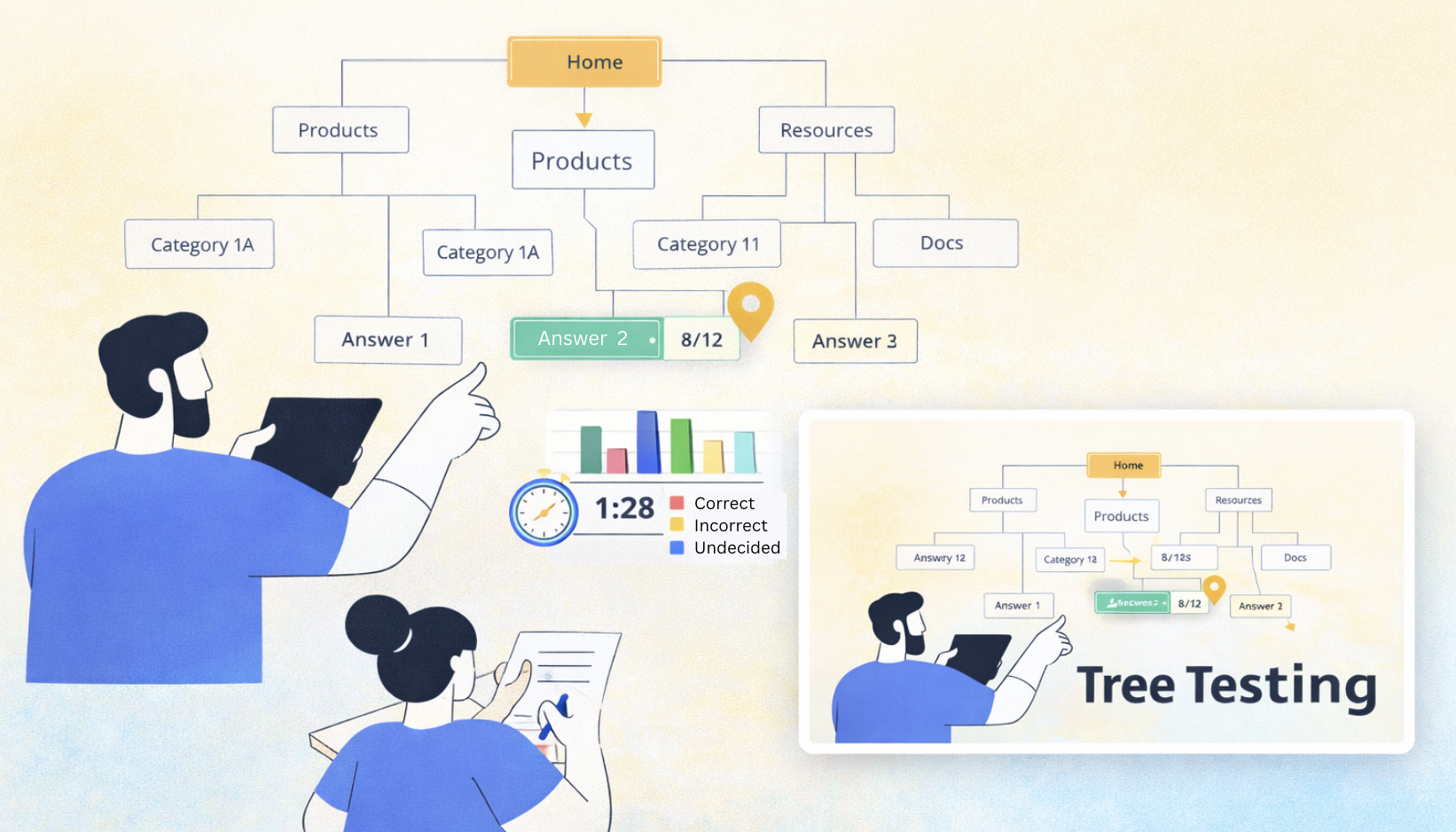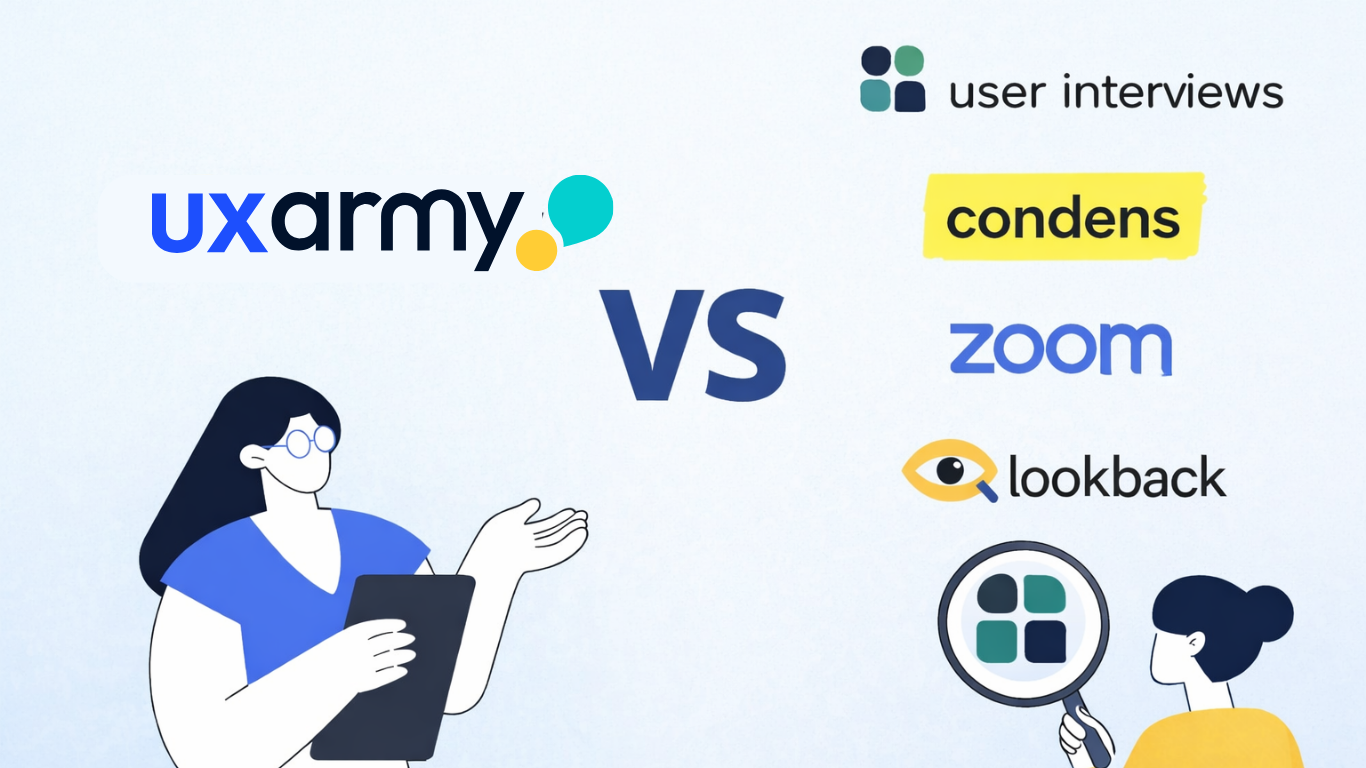UX research is evolving beyond individual usability tests and interviews – it now demands systems thinking, scalable infrastructure, and operational excellence. Enter UX Research Operations (ResearchOps), the backbone that ensures consistency, efficiency, and quality in growing research teams.
As product organizations mature, user testing platforms, usability testing tools, and UX research software play an increasingly critical role. But simply buying tools isn’t enough. To truly achieve scale, teams must adopt the right technologies while maintaining methodological rigor and trust with stakeholders and participants.
This blog explores how to streamline by scaling UX Research using the right tools – ensuring research is consistent, repeatable, and impactful.
“If UX is the voice of the user, then ResearchOps is the microphone, amplifier, and equaliser.” – Kate Towsey, Founder of the ResearchOps Community
What Is UX Research Operations (ResearchOps)?
ResearchOps refers to the orchestration and optimization of people, processes, and tools to enable impactful, consistent, and scalable UX research. It includes participant recruitment, data management, governance, compliance, tooling, knowledge repositories, and team coordination.
ResearchOps is essential in organizations where research isn’t just an event – it’s a function. It bridges the gap between researchers and product teams by standardizing workflows, safeguarding data, and ensuring that insights are effectively stored, shared, and acted upon.
When set up well, ResearchOps turns chaotic, ad hoc studies into a sustainable research practice with long-term value.
Ready to build that trust and kickstart your research?
let’s make trust the foundation of every project you work on.

Research Ops Pillars
Scaling UX research is not just about running more studies – it requires structured systems that support consistency, governance, and velocity. Research Operations (Research Ops) is the backbone of any mature UX practice. The following foundational pillars enable teams to scale research without sacrificing quality or insight integrity.
Participant Management
At the heart of research is access to the right users. A strong Research Ops framework includes systems for recruiting, incentivizing, and maintaining compliant user panels. Whether through integrated panel tools or CRM-syncing capabilities, this pillar ensures that researchers aren’t starting from scratch for every study.
Standardised Processes & Templates
Templates for usability tests, interviews, and surveys reduce onboarding time and ensure consistency in study design. Well-documented workflows also empower non-researchers to conduct high-quality research – democratizing access without compromising rigor.
Knowledge Management
Insights lose value when they’re buried in siloed decks or personal drives. A central repository – tagged, searchable, and version-controlled – makes past research discoverable and reusable. This pillar supports institutional memory and prevents redundant work.
Governance & Ethics
Research at scale introduces risk. Research Ops ensures compliance with privacy laws (e.g., GDPR, HIPAA), standardizes consent collection, and defines protocols for data handling. Ethical rigor isn’t optional – it’s operationalized.
Tooling & Automation
Modern Research Ops relies on integrated tools for scheduling, transcription, analysis, and reporting. These tools should reduce manual work, enhance data integrity, and support real-time collaboration across teams. Platforms like UXArmy centralize much of this infrastructure.
Enablement & Training
To truly democratize research, teams need more than access – they need confidence and competence. Research Ops must invest in onboarding materials, office hours, and mentorship loops that guide stakeholders in using research tools responsibly and effectively.
Cross-Functional Alignment
Research Ops isn’t isolated – it’s a connector. Aligning research practices with product, engineering, data, and legal functions ensures that research outputs integrate seamlessly into product development cycles.
“Research Ops transforms research from an art performed by a few into a system run at scale by many – without sacrificing quality.”
These pillars are not static – they evolve with the maturity of the team, the complexity of the organisation, and the velocity of product development. Investing in Research Ops isn’t just operational – it’s strategic.
The Challenges of Scaling UX Research
Fragmented Workflows
Without proper systems in place, teams struggle with scattered data, duplicated efforts, and inconsistent reporting formats.
Inefficient Recruitment
Finding participants is often time-consuming. Manual outreach and spreadsheet tracking don’t scale.
Insight Silos
Research data lives in notebooks, slides, or one-off decks, making insights inaccessible to cross-functional teams.
Tool Overload
With dozens of tools available, teams either underuse them or struggle with disconnected systems that create more work.
Compliance & Ethics
As privacy regulations tighten (e.g., GDPR, CCPA), ensuring participant consent, anonymization, and ethical research becomes increasingly complex.
“Scaling research is less about doing more interviews – and more about doing smarter operations behind the scenes.” – Nikki Anderson, ResearchOps Consultant
How Tools Can Streamline UX Research Ops
The right tools don’t just save time – they institutionalize best practices. By automating the repetitive and organizing the complex, ResearchOps tools enable researchers to focus on strategy and insights.
Automation
Tools can automate scheduling, reminders, incentive distribution, transcription, and reporting. This reduces admin overhead and speeds up turnaround.
Standardization
Templates, research playbooks, and reusable question libraries ensure methodological consistency across researchers and teams.
Accessibility
Platforms that offer centralized repositories (like research libraries) help democratize findings, allowing non-researchers to search and explore insights.
Scalability
Whether you have 3 researchers or 300, tools make it easier to support remote usability testing, global recruitment, and multilingual studies.
Key Categories of Tools in ResearchOps
1. Participant Management
- Examples: User Interviews, Rally UXR, Respondent, Ethnio
- Purpose: Automate recruiting, screening, and scheduling with compliant workflows.
2. Data Capture & Testing
- Examples: UXArmy, Maze, PlaybookUX, Lookback
- Purpose: Conduct moderated/unmoderated testing, surveys, and interviews.
3. Analysis & Synthesis
- Examples: Dovetail, Aurelius, Condens
- Purpose: Tag, cluster, and analyze research data in one collaborative space.
4. Knowledge Management
- Examples: Notion, Confluence
- Purpose: Create searchable, shareable research repositories.
5. Compliance & Consent
- Examples: UXArmy (Consent Tools via NDA), GDPR plugins
- Purpose: Capture informed consent, manage data privacy, and meet regulatory standards.
Case Study: Scaling ResearchOps in Practice
Challenge
Galuhuria was the only UX researcher in the company MyWheels, a consumer lifestyle tech platform. She reported significant inefficiencies due to: Limited access to B2B customers – recruitment relied on customer-facing teams (customer success or sales) causing delays. Manual logistics overload – using Zoom, Google Sheets, Calendars, and email slowed down research planning and execution. Conducting even a few studies per month involved a heavy admin workload.
Solution
MyWheels implemented a unified UX research platform that automated recruitment, scheduling, testing, and repository workflows:
- Centralized participant panel linked to Salesforce, enabling segmentation by vertical or usage behavior
- Built-in unmoderated prototype testing with auto metrics (clickmaps, success rate, timing, misclick detection)
- Research repository with templated screens and synthesis features for stakeholder sharing
Results & Impact
Efficiency Gains Saved over 30 hours per month, reallocating ~10 hours per study from logistics to analysis. Improved study throughput: running three studies per month became sustainable.
Targeted Recruitment Faster access to qualified participants via CRM integration – enabling segmentation by verticals and usage profiles. Increased panel diversity and reduced reuse of participants.
Rich Insight Generation Adoption of unmoderated prototype testing unlocked new methods previously too cumbersome. Automatic analysis tools delivered immediate metrics and video support to drive decision-making.
Organizational Alignment
Research repository enabled democratization: support for marketing, customer success, and design teams. Stakeholders received direct customer quotes and video evidence, enhancing trust and decision validation.
Best Practices for Implementing ResearchOps Tools
- Start with a process map before adopting tools. Understand pain points and workflows.
- Pilot before rollout. Test with one team or study before scaling platform-wide.
- Document everything. Make guides, training decks, and playbooks for future researchers.
- Ensure cross-team buy-in. Collaborate with legal, IT, design, and product.
- Monitor tool usage. Regularly assess adoption, impact, and ROI.
- Train for ethical usage. Prioritize tools that promote privacy, consent, and transparency.
Ethical Considerations and Trust Factors
Ethics must be embedded in research tooling and operations. From participant recruitment to insight reporting, tools should be used to uphold transparency, consent, and data protection.
- Choose vendors that prioritize data security and offer clear privacy policies.
- Standardize consent capture with consistent language and storage.
- Train teams on how tools manage user data and where responsibilities lie.
“Good ResearchOps respects users not just during the test, but in how we handle their data, time, and insights after.” – Cassie Robinson, Designer and Social Researcher
Expert Insights from the Field
- Hannah Shamji, ResearchOps Strategist: “Every high-functioning research team I’ve seen succeeds because they built systems – not just skills.”
- Steve Portigal, Author of Interviewing Users: “The more repeatable our research gets, the more essential it is to treat each participant as unique.”
- Katya Ivanov, Lead UX Researcher at SaaSCo: “Adopting tools was the easy part. Building trust around how we used them took real effort.”
- Katelin Holloway, Rally UXR Advisor: “Scaling participant management isn’t just about speed – it’s about respect. Tools like Rally are changing how teams honor user time.”
Scaling UX research isn’t just about doing more – it’s about doing it better, faster, and with greater consistency. ResearchOps tools are enablers of that vision. They streamline complex workflows, standardize methods, and make insights more impactful.
Success lies not in tools alone, but in how thoughtfully they’re implemented. With the right strategy and the right tools, UX research can move from reactive to operationally excellent – and drive more informed, user-centered decisions.
Suggested Reading
Experience the power of UXArmy
Join countless professionals in simplifying your user research process and delivering results that matter
Frequently asked questions
What exactly does ResearchOps include?
ResearchOps encompasses all the behind-the-scenes operations that support UX research: participant recruitment, tool management, data governance, compliance, knowledge sharing, and research planning. It enables researchers to focus on generating insights rather than managing logistics.
How do tools help scale UX ResearchOps?
Tools automate repetitive tasks, standardize workflows, centralize insights, and ensure compliance. This allows research teams to scale their impact without compromising quality or ethics.
What are the biggest signs that a team needs to formalize ResearchOps?
Key indicators include inconsistent recruitment, duplicated studies, scattered research data, compliance concerns, and researchers spending more time on coordination than actual research.
Can small teams benefit from ResearchOps tools?
Absolutely. Even solo researchers can benefit from tools that streamline recruitment, automate analysis, and organize insights – setting a strong foundation for future scale.
How should we prioritise tool selection for ResearchOps?
Start with tools that solve your highest-friction problems – usually participant management and research documentation. Focus on integrations, user-friendliness, and data compliance features.




